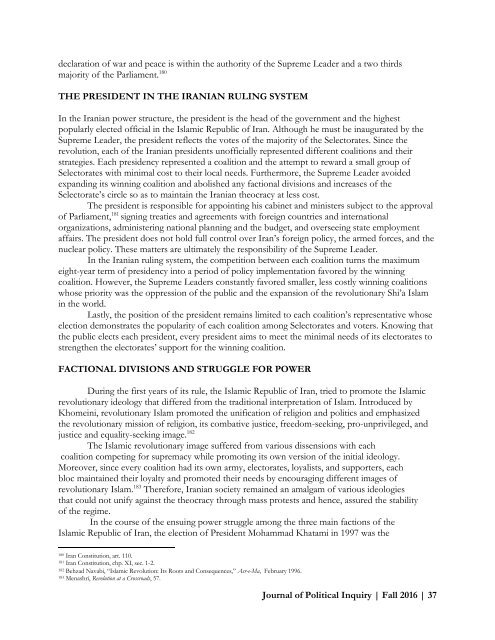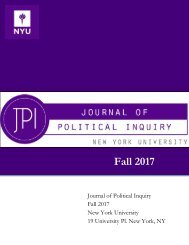Fall2016_Final2
Create successful ePaper yourself
Turn your PDF publications into a flip-book with our unique Google optimized e-Paper software.
declaration of war and peace is within the authority of the Supreme Leader and a two thirds<br />
majority of the Parliament. 180<br />
THE PRESIDENT IN THE IRANIAN RULING SYSTEM<br />
In the Iranian power structure, the president is the head of the government and the highest<br />
popularly elected official in the Islamic Republic of Iran. Although he must be inaugurated by the<br />
Supreme Leader, the president reflects the votes of the majority of the Selectorates. Since the<br />
revolution, each of the Iranian presidents unofficially represented different coalitions and their<br />
strategies. Each presidency represented a coalition and the attempt to reward a small group of<br />
Selectorates with minimal cost to their local needs. Furthermore, the Supreme Leader avoided<br />
expanding its winning coalition and abolished any factional divisions and increases of the<br />
Selectorate’s circle so as to maintain the Iranian theocracy at less cost.<br />
The president is responsible for appointing his cabinet and ministers subject to the approval<br />
of Parliament, 181 signing treaties and agreements with foreign countries and international<br />
organizations, administering national planning and the budget, and overseeing state employment<br />
affairs. The president does not hold full control over Iran’s foreign policy, the armed forces, and the<br />
nuclear policy. These matters are ultimately the responsibility of the Supreme Leader.<br />
In the Iranian ruling system, the competition between each coalition turns the maximum<br />
eight-year term of presidency into a period of policy implementation favored by the winning<br />
coalition. However, the Supreme Leaders constantly favored smaller, less costly winning coalitions<br />
whose priority was the oppression of the public and the expansion of the revolutionary Shi’a Islam<br />
in the world.<br />
Lastly, the position of the president remains limited to each coalition’s representative whose<br />
election demonstrates the popularity of each coalition among Selectorates and voters. Knowing that<br />
the public elects each president, every president aims to meet the minimal needs of its electorates to<br />
strengthen the electorates’ support for the winning coalition.<br />
FACTIONAL DIVISIONS AND STRUGGLE FOR POWER<br />
During the first years of its rule, the Islamic Republic of Iran, tried to promote the Islamic<br />
revolutionary ideology that differed from the traditional interpretation of Islam. Introduced by<br />
Khomeini, revolutionary Islam promoted the unification of religion and politics and emphasized<br />
the revolutionary mission of religion, its combative justice, freedom-seeking, pro-unprivileged, and<br />
justice and equality-seeking image. 182<br />
The Islamic revolutionary image suffered from various dissensions with each<br />
coalition competing for supremacy while promoting its own version of the initial ideology.<br />
Moreover, since every coalition had its own army, electorates, loyalists, and supporters, each<br />
bloc maintained their loyalty and promoted their needs by encouraging different images of<br />
revolutionary Islam. 183 Therefore, Iranian society remained an amalgam of various ideologies<br />
that could not unify against the theocracy through mass protests and hence, assured the stability<br />
of the regime.<br />
In the course of the ensuing power struggle among the three main factions of the<br />
Islamic Republic of Iran, the election of President Mohammad Khatami in 1997 was the<br />
180<br />
Iran Constitution, art. 110.<br />
181<br />
Iran Constitution, chp. XI, sec. 1-2.<br />
182<br />
Behzad Navabi, “Islamic Revolution: Its Roots and Consequences,” Asr-e-Ma, February 1996.<br />
183<br />
Menashri, Revolution at a Crossroads, 57.<br />
Journal of Political Inquiry | Fall 2016 | 37
















